
Video-Voicemail
Smart Phone Video Calls and Messages for:
- Friends and Families
- Business Workgroups
Video calls now exist and features like Skype's "video snapshot" enable still images to be combined with a video call. US Reissue Patent No RE42210 describes such combined calls including saving them in the manner of voicemails today. The acquisition of Skype by Microsoft raises the probability that video-voicemails according to this invention will be available on smart phones in the future.
Communicating Naturally
When we sit down to explain something to someone, it's a very natural process. We talk and point and talk and point and talk some more. In between, they ask questions and we respond. The conversation flows as such conversations have for millennia. Naturally.
Today, many of us find a large percentage of our conversations occur via mobile phone. Yet, some conversations still need to refer to objects which are the subject of the conversation. With the advent of the camera-phone, one can transfer pictures as part of the process, but this transfer is normally done as computers transfer pictures - essentially attached to emails or instant messages. Relative to a voice conversation on a mobile phone, this method is an un-natural act.
A more natural way for people to interact when discussing a subject that can be photographed, is for the person on the other end of the link to see in realtime what the originator is looking at, while they discuss the issues interactively. Again, as has been done for millennia.
A Video-Voice conversation, per this patented invention [US Patent 7,092,735 and Reissue Patent RE42210 that issued on March 8, 2011 with Broader Claims], enables this natural interaction, while preserving the flow and information intact in recorded Video-Voicemails, and recorded live Video-Voice conversations.
Q. What is Video-Voice conversation?
A. It’s like a wireless, mobile video conference, except you can save it like voicemail or record live conversations for later playback or archive.
While there are many applications for Video-Voicemail and Video-Voice conversations, we expect initial utility to be greatest in groups of friends and family as well as in construction work groups.
Family and Friends
A common scenario involves someone who is shopping, sees an interesting item, and wishes to get their spouse's opinion before they proceed to purchase the item. If the spouse could actually view the item and ask questions, the entire process can be expedited significantly.
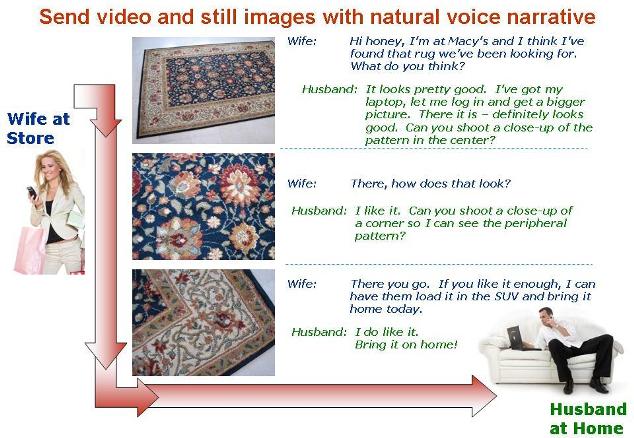
If the spouse is not available or they are driving and cannot view their phone, a Video-Voicemail is created which conveys the images and questions enabling the spouse to respond as soon as possible based on the most accurate information. In the meantime, the originator can continue shopping, returning to the item in question once communication with their spouse has been reestablished.
Construction Made More Efficient
Anyone who has had their home remodeled or hired a contractor for a major landscaping project has experienced the inefficiencies firsthand. Contractors typically have a number of projects under way simultaneously, and spend a great deal of time traveling from site to site. Invariably when questions come up at a particular site the contractor or Foreman is not at that location. With the advent of mobile phone technology, and in particular functionalities well-adapted to the construction industry such as Direct Connect™ from Nextel, workers and management attempt to resolve questions over the phone. Without being able to visually observe the subject in question, mistakes are invariably made and construction proceeds incorrectly. The common result of this is the correction of the mistakes which increases costs and delays the project. Basically “rip-up and re-try”.
Construction Work Groups
If the contractor or foreman is available to talk and view images when a worker has questions, the Video-Voice conversation can occur in realtime with high-resolution still images and video clips transferred such that their position in the voice stream is preserved.
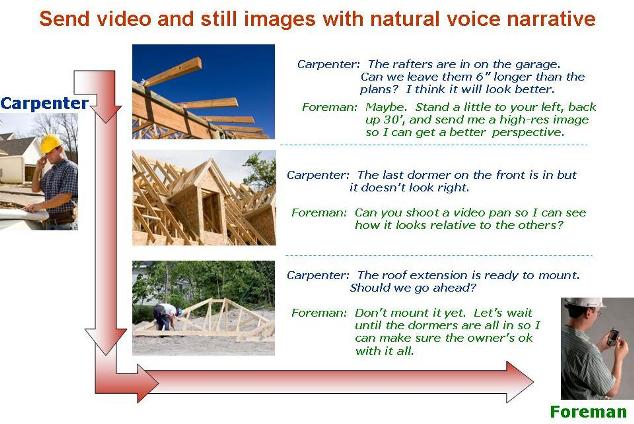
If the contractor or Foreman is unavailable, and the Video-Voice call goes to voicemail, the worker can still ask their questions including sending photographs and video clips of the subject. That “Video-Voicemail” will be saved at the mobile service provider and will be available for the contractor or foreman to review at their next opportunity. Meanwhile the worker can continue with other aspects of the project and will still get accurate answers to their questions in a timely manner, since they have provided a detailed audio visual explanation of the problems.
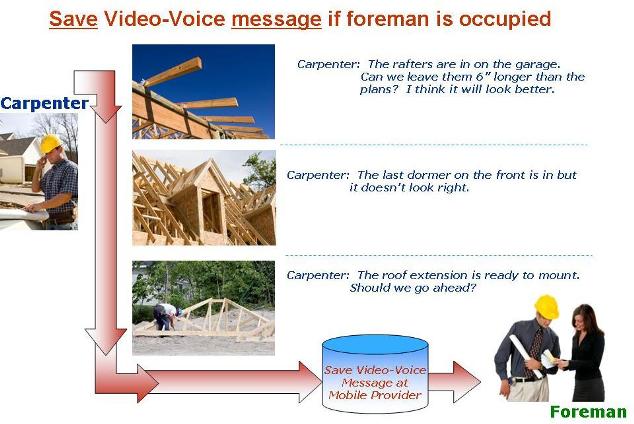
At times, the contractor or foreman may be available, but may be driving and thus not able to observe visual information on their phone. This need not prevent the conversation from occurring however, and the worker can ask their questions including providing images and video clips - the contractor or Foreman retrieving this information when their driving is complete. In this scenario, a realtime video voice conversation has been recorded, something that is never done today. Thus, various permissions need to be established to allow the recording of a realtime conversation, and the mechanisms for establishing permissions are included in granted claims of the Video-Voicemail patent.
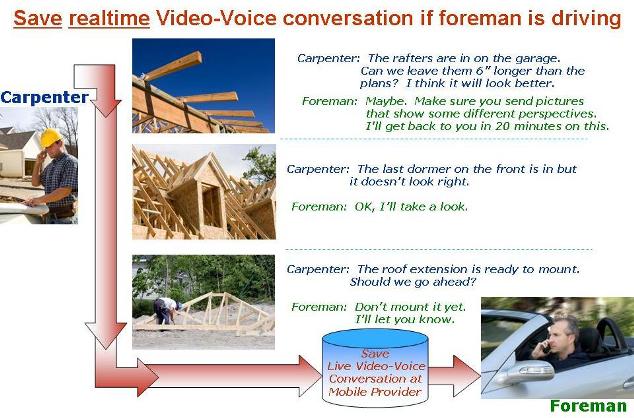
Besides the ability to record Video-Voice conversations for delayed review, it may be desirable that all Video-Voice conversations between specific parties are recorded for archive purposes in order to keep a more accurate project record. Such a capability is also covered in the patent claims.
Recently, Nextel began to offer a new capability called Direct Send™. Here, images can be sent during a realtime conversation between two people on a “walkie-talkie” call. While this is certainly useful, there is no provision for recording Video-Voicemail messages or alternately recording realtime Video-Voice conversations for delayed review or alternately for archive purposes.
The Video-Voice Paradigm
Different visual media are more or less appropriate in different applications. For instance, to show another party the relative position of a particular subject item, a video clip may be most useful as the originator can “pan” during the video clip to show relative position. For instance, in this photograph sequence a video pan is executed to show the relative position of a break in a pipe.
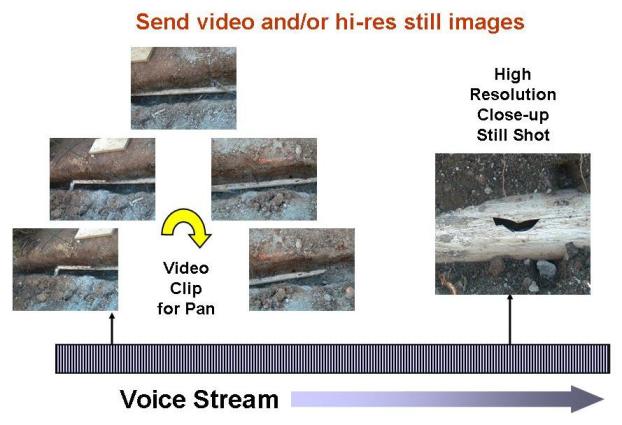
Then, once the relative position has been established, a high resolution still image may be far more appropriate for showing detail required for a decision to be made. As evidenced here, a close-up high-resolution image shows the severity of the break and enables the parties to decide if the pipe should be patched or replaced.
In all of these scenarios, the position of video clips and high resolution still images in the voice stream is maintained for both real-time and recorded conversations.
The data flows for various Video-Voice scenarios are shown in the following diagram:
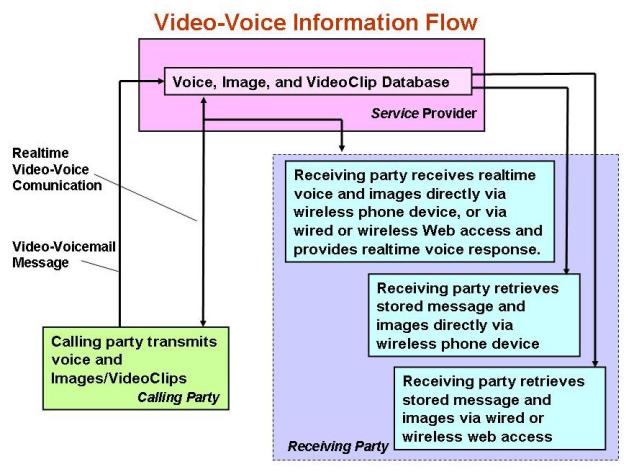
In many cases the receiving party will be a contractor or foreman who will often be at an office location, or will have a laptop computer with a relatively large screen and occasional Internet access. In such cases, a paradigm may be established where this party can log into an access portal at their mobile service provider and be able to view Video-Voice images on the larger screen of a laptop or desktop computer. This can be synchronized with voice received via their mobile phone, or alternately the voice conversation can be diverted through the Internet and provided for them through their computer as a VoIP stream - received through a headset attached to their computer.
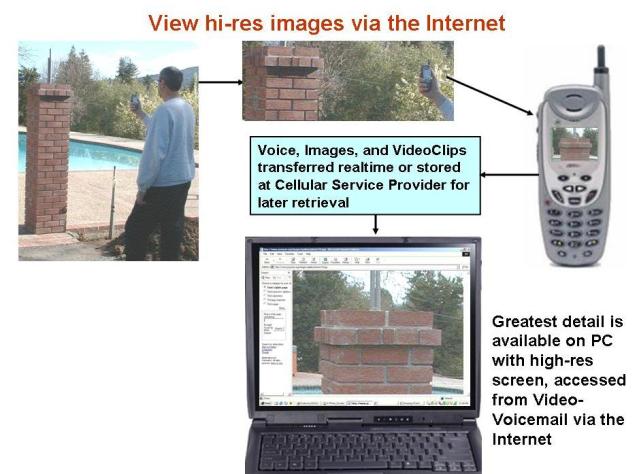
Other Applications
A variety of other applications exist.
Medical
Paramedics can communicate with doctors located at a central location during emergencies and convey visual information as part of a Video-Voice conversation. Recording of this realtime conversation is critical for archive purposes.
Visiting nurses and/or personnel providing home eldercare can communicate with doctors and nurses at central locations including visual information, again with the entire interaction being recorded for archive purposes.
Building Inspection and Insurance Adjusters
A building inspector or insurance adjuster can provide audiovisual information as part of an on-site inspection, that information being recorded at a central location for later retrieval both for their own purposes in creating their report, and also for archive purposes.
Field Service
A field service technician can communicate with an expert at a central location, providing visual information during a realtime or recorded Video-Voice message, enabling them to better diagnose a problem and make more efficient use of the field service call.
Summary
The ways people communicate with phones today are well established -- you make the call, if the other party is available you talk, if they're not, you leave a message. It's the natural way to communicate. The Video-Voice paradigm described in US Patent 7,092,735 builds upon this natural mechanism adding high-resolution images and video clips to the conversation. The Reissue Patent (RE42210 issued on March 8, 2011) broadens the claims to more definitively cover the Video-Voicemail paradigm. The pending Reissue Continuation application (13/018,314) focuses on communication paths and display resolutions.
With Video-Voicemail, if the other party is not available, you still leave a message - it just has more information than before. And, if you want a record of what was said, you can record a realtime conversation, something that is never done today but can be extremely useful. Video-Voice communications and Video-Voicemail are the next generation of mobile communications for friends, families, and mobile workgroups.